If you own a concrete or plaster swimming pool, or are about to become the proud owner of a plaster-surfaced pool, we have some pointers to help you keep it looking like paradise. Plaster pool finishes are traditionally the most popular swimming pools dating all the way back to the very first backyard pools. Typically a mixture of cement and fine, crushed marble sand, otherwise known as marcite, it’s a durable resistant surface.
Perhaps best of all, they can be sculpted into almost any shape your budget can afford. Additionally, gunite pools are very sturdy and strong because of the steel framework.
How to Identify and Remove Stains in a Plaster Pool
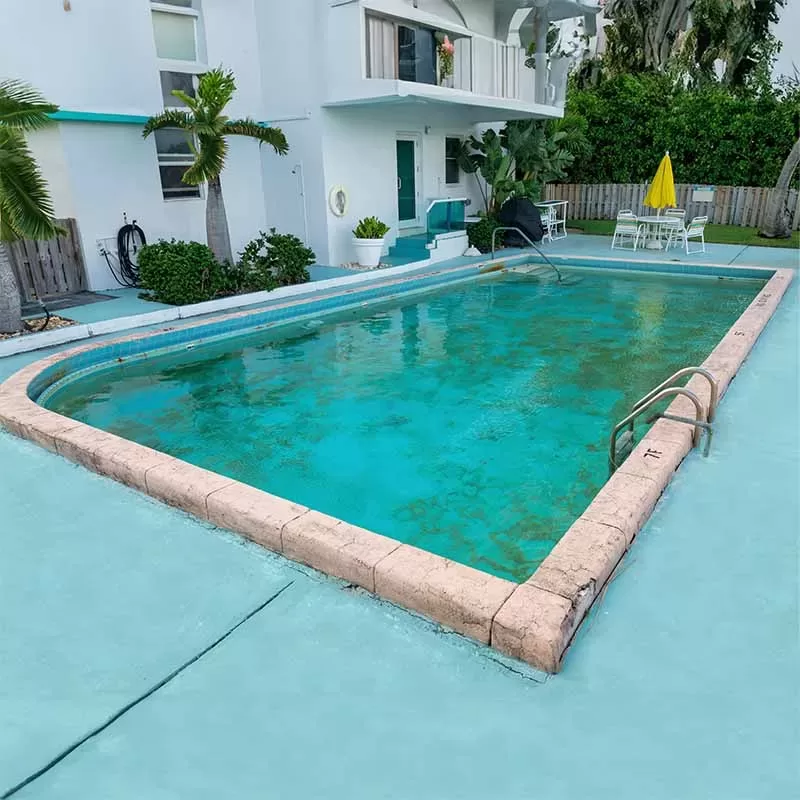
Invisible metals dissolved in your pool water from sources like rain run-off, pool equipment, saltwater pool systems, or even your concrete pool deck surface. Bits of metal like screws or hair pins can make a nasty rust stain.
A great product for removing metal from your pool is Metal-Free by Natural Chemistry. It is one of the strongest products available for sequestering metals. It works especially well on well water, is not affected by pH or temperature, and is all natural. The Sapphire Stuff by Jack’s Magic is another fantastic sequestering agent. It not only removes metals, but also oils, soaps, cosmetics and other organic matter from your pool water.
For oily stains at the waterline, or a bathtub ring from winterization water levels, use an enzyme product like Pool Perfect to consume oils, fats and other greasy pollutants that enter the water.
Identifying Plaster Pool Stains
It’s important to know what kinds of metals are creating the stains in your pool. Here’s a pool stain chart as a guide for metal stain identification in pools:
| Metal | Sources | Colors |
|---|---|---|
| Calcium | Plaster, grout, mortar, or cal-hypo shock | White crystals or precipitate |
| Copper | Copper algaecides, ionizers, corrosion of copper pipes, fittings, or heat exchanger | Blue, green, blue/green, black, or teal |
| Iron | Well water, corrosion of iron pipes or fittings | Dark red, brown, grey, black, or green |
| Manganese | Well water | Pink, red, or black |
Removing Plaster Pool Stains
Metals are certainly not the only cause of stains in a plaster-surfaced swimming pool. Leaves, berries, bugs, sun tan oil, or even your water-loving dog can all contribute to staining. These types of stains can be cleaned with good old fashion elbow grease using a combination of a pumice stone and pool shock. Pouring a bit of pool shock directly onto a stain works similar to bleach and is ideal for plaster surfaces, but a bit harsh for vinyl liners.
The Stain Eraser is another great stain removal product that does not require the use of chemicals and is great for smaller stains and stains in tough corners. It’s designed to be mildly abrasive so it’s tough but not destructive to the plaster.
For extreme staining or serious algae blooms, plaster pools can be cleaned with an acid wash with muriatic acid, or the safer to use Acid Magic. Acid washing removes a thin layer of plaster, exposing bright white and unstained plaster underneath. Having your pool acid washed will remove most surface stains.
Finally, keep your pool water balanced, with good pH, alkalinity and calcium hardness levels. A pool that is out of balance can stain more easily, and makes stain removal difficult as well.
For plaster pool stains, it’s best to always start with the brushing and shock before going in with a bunch of trial and error stain removers. With staining, patience is a virtue. If you have balanced the water, brushed and shocked, and you still find staining, then try one of our pool stain removal chemicals.
Other Stains
These can include pool stains from mineral scale like calcium and metals like copper, iron or manganese. Minerals can come out of solution in hard water, and metals can enter from fill water that is high in metals, or from copper pipes or a pool heater exchanger – when water balance is not correct.
Poor water balance can become corrosive or scaling, and both conditions can cause plaster pool stains by making it easy for minerals and metals to come out of solution.
Sequestering agents, commonly called stain and scale chemicals, can help keep minerals and metals in solution, locked up tightly at the molecular level, so they won’t precipitate, mix with other particles, and then attach to your pool surfaces.

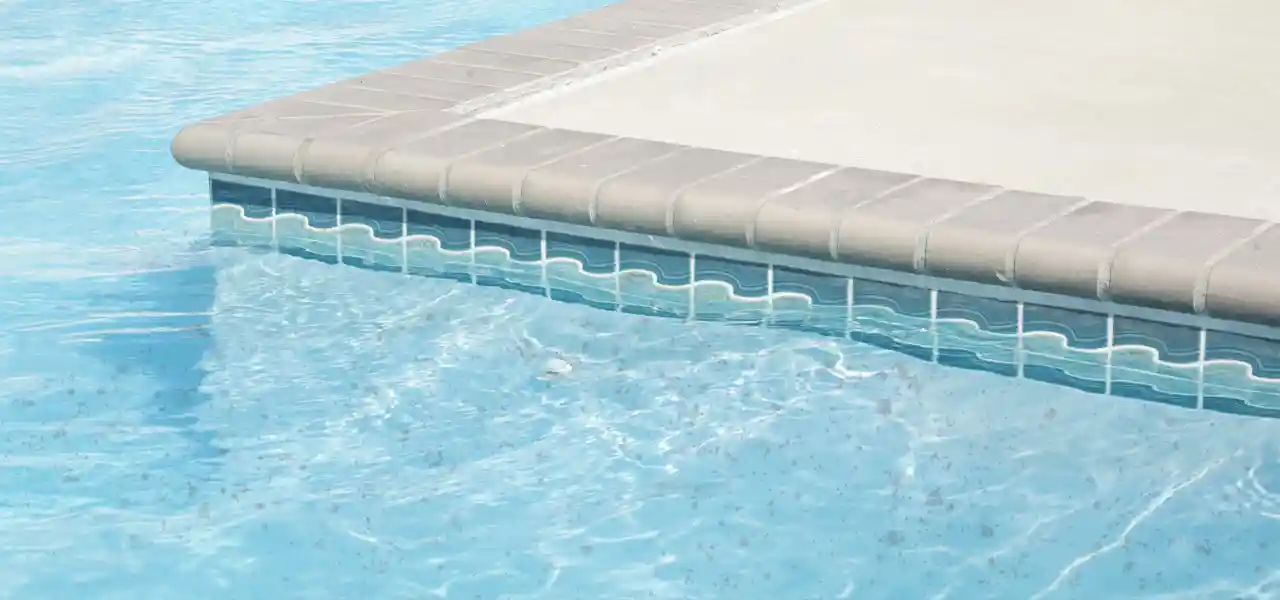
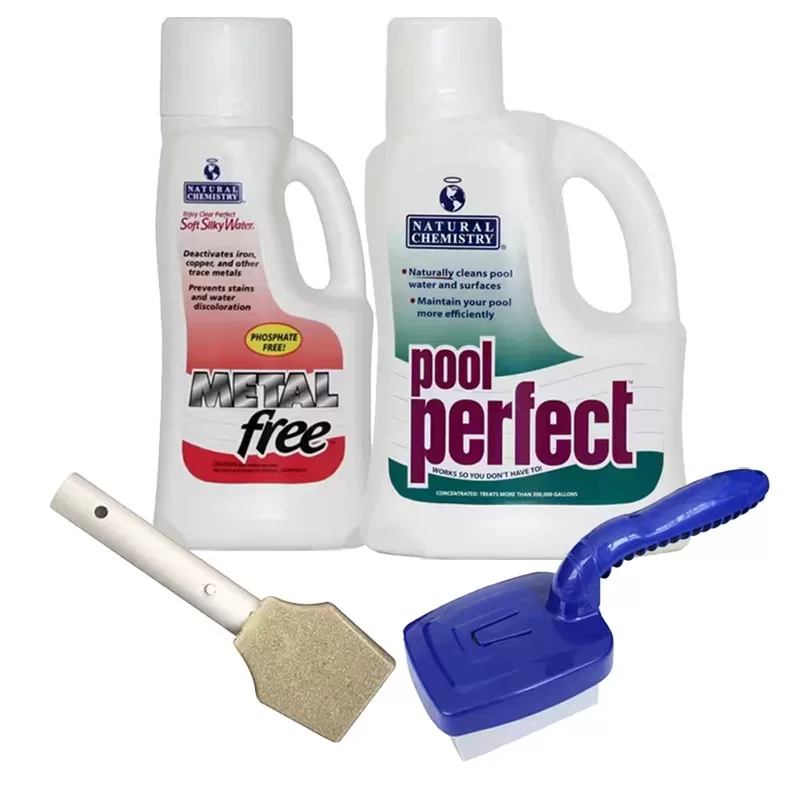

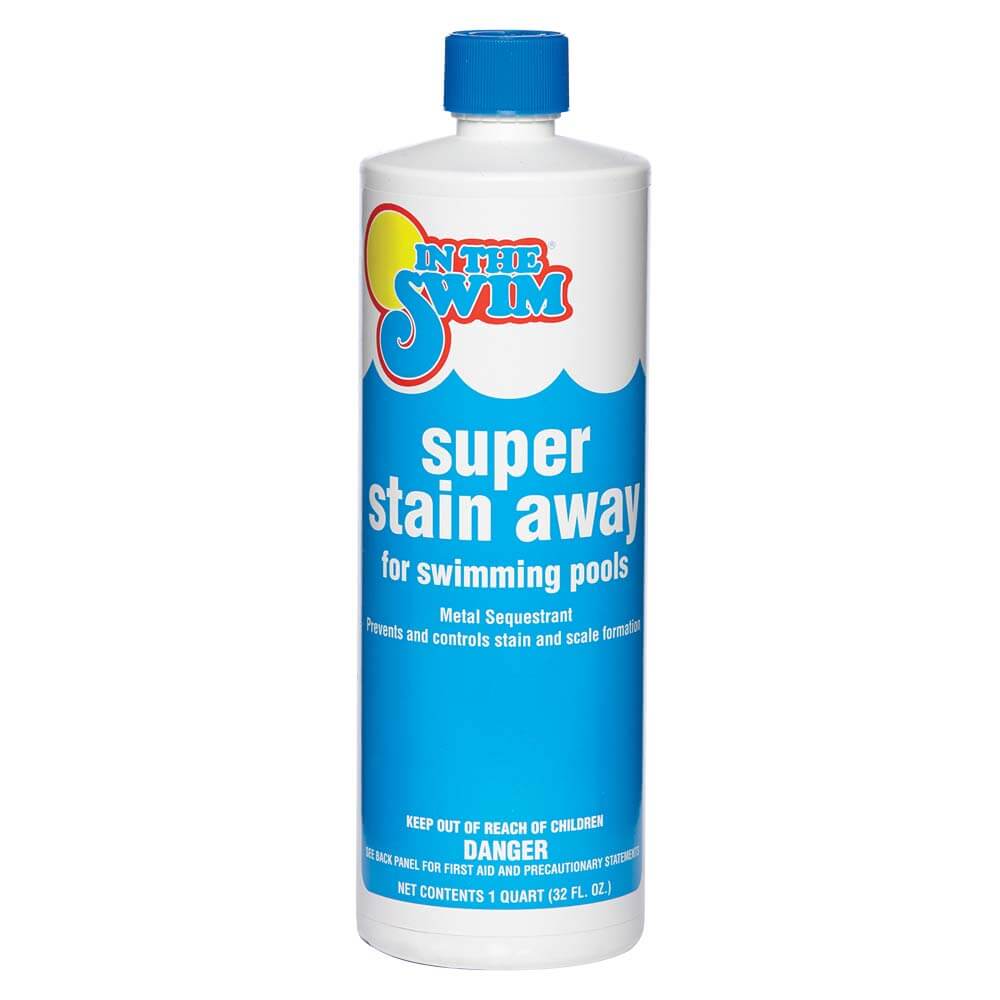
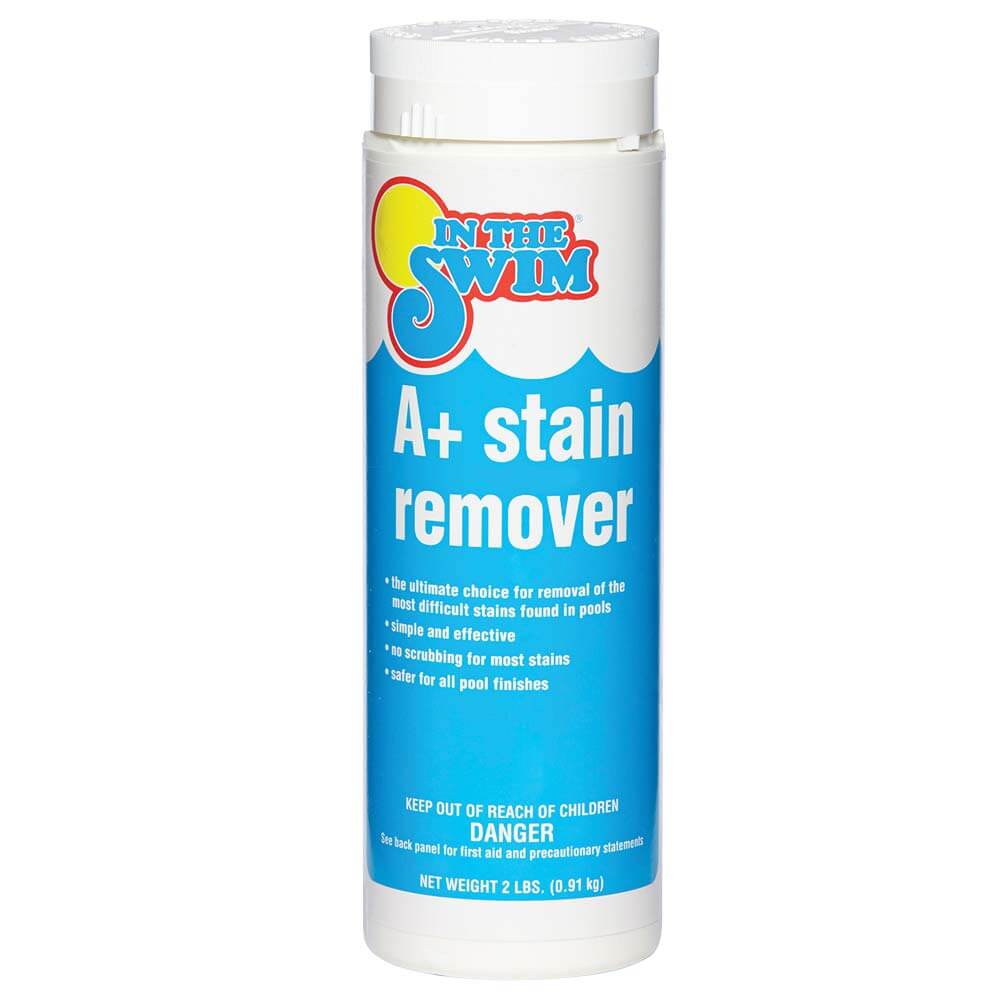
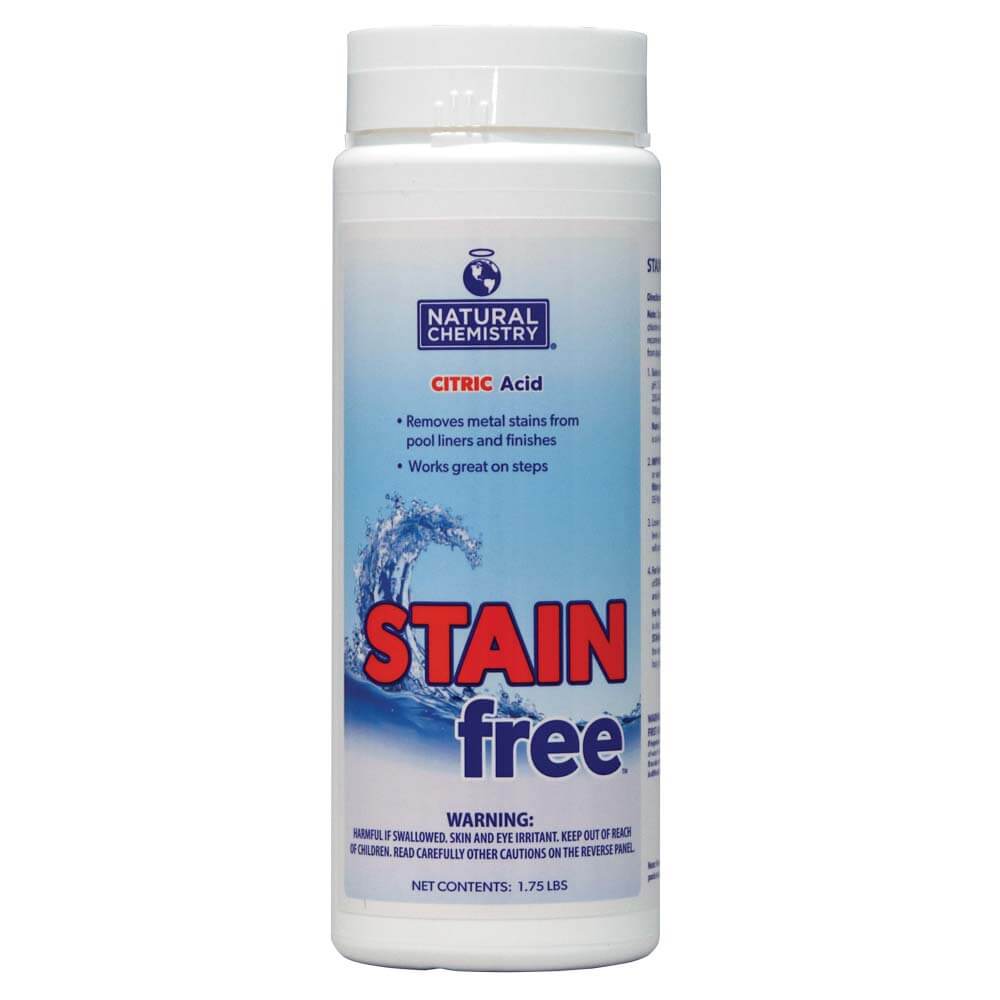
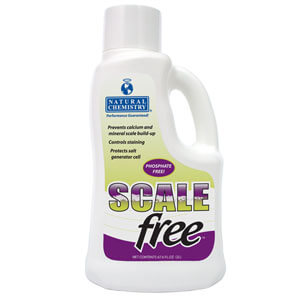


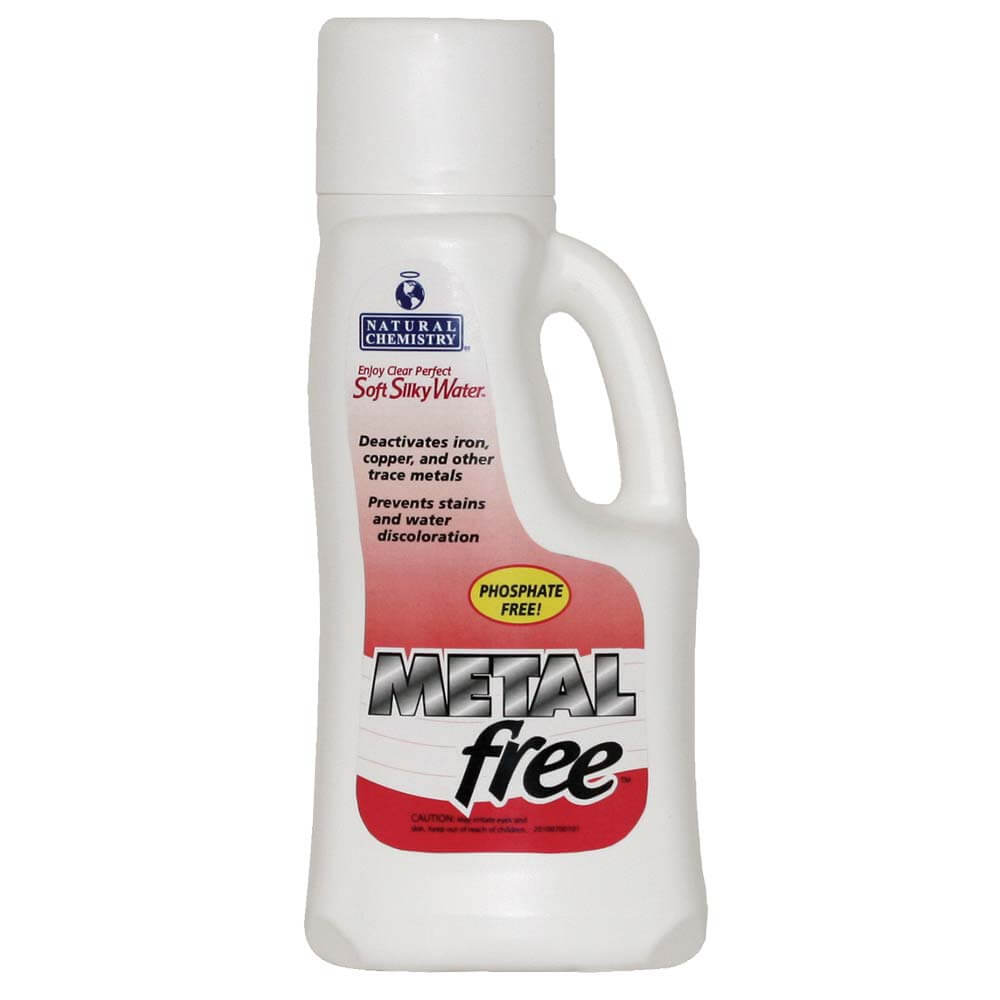


Hi Davy,
What a great resource this is! We have an indoor plaster swimming pool. Approximately 19000 gallons. We recently had to empty it because several small pieces of the pour in place rubber flooring started quickly breaking down and falling into the pool. We’ve also have a reoccurring algae issue. Now that I’ve emptied the pool, there are several spots where the algae is proving to be difficult to remove. I’ve tried the pool brush and water but it’s not coming off easily. There are also a few black rubber scuff marks from me getting in and out of the deep end. What would you recommend moving forward?
Julius, for the algae, you could ‘bleach wash’ the pool, or rent a pressure washer, which would also get rid of the scuff marks.
Thank you for the quick response. Buy bleach washing do you mean dilute some bleach in a bucket and then scrub with a brush?
I have a pressure washer. If I go that route would you recommend putting any sort of soap into the dispenser?
Yes, exactly, make a bleach solution and spray it or splash it on the cover. If it is bacteria that should kill it. A pressure washer could also be a good idea, and should remove it well, perhaps without soap, but can use if needed.
Hi there,
I have a question about stains left by plastic. My Dolphin sweeper (with black putter casing) is leaving black marks all over my newly plastered white pool! Especially on and around steps and benches. We have tried scrubbing them off with a brush but have had little success. What should we try?? Thanks!
Hi Alesha, oh how awful! 🙁 We have a product that does pretty well with that, actually two come to mind. One is the Stain Eraser, kind of like a big pencil eraser… and second is the PoolStone, a synthetic pumice stone used for scrubbing plaster pools.
I have a 25,00 gallon plaster pool. I just added 2 lbs of granular In The Swim Pool Shock directly to the water. However, I did not have the pump running. With a few minutes the plaster turned blackish brown wherever the shock had landed. I scrubbed with a brush & even tried to power wash the stains with a heavy duty Pressure washer, Stains won’t change. I’d sure appreciate some advice.
Hi Tom, that is from metals, either copper or iron. Sometimes these stains will disappear on their own. If not, use a Sequestering agent to (hopefully) reabsorb the metals into solution. Something like Stain Away or Metal Free, or Jack’s Magic Blue Stuff – lots of options. And since you have a metals problem, you should use regularly, adding maintenance doses, per label. If the Sequestering agent does not help, the next idea is to drain and acid wash the pool.
Our city water has a lot of calcium and my new pool now has light brown stains through out the pool especially on the steps and the skimmers. What can I do short of emptying the pool and acid wash?
Hi Sam, be sure to keep the pH level on the low end, 7.2 to 7.4. If the calcium deposits are nodules, you can try to remove with a pumice stone, or PoolStone. You can also try a heavy dose of sequestering agent like our Stain Away, after balancing the pH and alkalinity levels. Scale Free is another good sequestering agent, formulated for calcium levels.
Just finished treating my pool for Mustard Algae. It now looks like my plaster is stained along the all four sides. The water is crystal clear. The chorline levels are at 10.it is never this high just due to the large amounts of shock that followed the treatment of Yellow Out. PH 7.2-7.4
Alkinality 80. Have been running the filter continually.
Is it likely the staining will diminish in time.
Hi Diane, yes the discoloration will fade over time, you are doing all the right things. Check the calcium levels, to be sure calcium hardness is not too low, but above 180 ppm. Also, when treating for out of control Yellow algae, it is advised to replace the filter media (sand, cartridge or DE grids)
Hey Davy. I had the pool sweep discount from the hose so the hose was whipping around the bottom and side of the pool. In the process it left black scuff marks all over the place. What’s the best way to get the marks of? It looks like a black mark that a black soled tennis shoe would leave on a basketball court. Lots of little ones. Any help would be appreciated. Jason
Hi Jason, generally that would be plastic marks, I suppose. A Magic Eraser may help. A pumice stone or PoolStone block may also work. If those don’t work, try softening it by sprinkling a chemical like pool shock directly over the stain, or an acidic stain remover like EZ Stain or A Plus pool stain removers.
Briefly, last 3-4 years I constantly get these “stains” but they are hard white cystalized stains…not sure if calcium…on side walls of pool usually very thin, long and all white, easy to get off with pumice. But bottom of pool, all over they are more round in shape, with dirt baked in from pool. These are harder to get off with pumice and sometimes leave like a coffee stain. I had so many last few months…they all have the base–white, hard, crystalized, then usually dirt of top. Last two days took pumice to probably about 50 of them. About 10-15 of the 50 left a stain behind where crystal formation removed. I then used 3 jugs of muratic acid and pvc pipe to get those stains removed.
What can this white crystal (different formations) be? I’m thinking calcium?? I have salt water pool with water fall.
Also, since I used so much Muratic Acid should I shock pool? Change salt water generator panel to super chlorinate?
Hi Mike, yes most likely calcium, and mixed with sodium from the salt, and as you rightly assume, mixed with dirt and other contaminants. Salt water pools typically have a rising pH level, and when pH levels rise above 8.2 and higher, it can cause calcium to come out of solution, and deposit on walls and floors, in sheets and nodules. The first thing to do is to keep the pH level around 7.4, lowering pH regularly, and even during winter if necessary, to keep calcium scale from forming. Secondly, use a sequestering agent like our Stain Away or Metal Free or Jack’s Magic Blue Stuff, to keep minerals and metals in solution, where a high pH (or other causes) won’t force the minerals out of solution. Add an initial dose, then add the smaller maintenance dose, indicated on the label, to keep the level of sequestering agent constant, for continued protection.
Hi Neil, I had my pool replastered 7 yrs ago with diamond brite pool plaster and was very happy with it. 5 yrs later the pool had accumulated a high concentration of cyanuric acid and I decided to drain half the water and refill the pool, this occurring in August. in the middle of draining, the pool pump quit on me. it took me awhile to get a new pump installed all the while fall, winter and spring came and gone and my pool was full of leaves and debris along with the ugliest black and green ring stain around the middle of the pool. I had a pool company come out and acid wash it and had them close it for the winter, plus covering it. This spring the cover was removed and the water looked great. However, that lasted until the first rain and it started get algae but it started around where the ring was and it was both black and green. I had the pool guys out and scrub and balance the water. The water did turn blue but it was cloudy and I thought with time it will clear up. 3 months now and my water looks like pond water I gave up with calling the pool guys. I don’t know if I should have it drained and acid washed again or just have it replastered since I think the mold ring is in-beded in the plaster.
Hi Richard, likely that there is some embedded algae around the ring, some algae can put down roots in the plaster. I would suspect some other problems to be the main contributing factors however, specifically a small size filter or poor performing pool filter, and/or not running the filter pump long enough each day, and/or not maintaining good water balance and a high enough, consistent and constant chlorine level. Blue and clear pool water requires a careful balance of circulation, sanitation and filtration – along with effective cleaning processes to remove organics and good water balance so the chlorine can be most effective (and testing with a real test kit). Finally, your pool may have a contamination of phosphates, perhaps from heavy debris or rain water washing into the pool. You can test for pool phosphates and remove with phosphate removers like PhosFree.
From John Zanotti (moved from earlier post) I have a marcite pebble finished pool.l have stains in the deep end of pool.At first the brown stains looked like metal rust like stains. I continuely monitor pool & has no metal (rust) in the pool. Brushing doesn’t remove them. I have several large sycamore trees over pool. Think that the bark from the trees are the cause.Can you help
Thanks.
Hi John, for tannin stains, from bark or leaves sitting on the surface, a simple sprinkling of shock (granular chlorine pool shock) over the area will lift the stains, or bleach them out. Add a pound or two, let it sit for a few minutes on the surface, then brush off. Adjust pH to the low side, around 7.2, for best result. If that doesn’t work, then I would try sprinkling EZ Stain Remover over the area, following label instructions.
From Jacqueline (moved from earlier post) I recently bought a house and the pool was not cleaned until closing. When I saw the pool it was completely stained. It looks exactly like the picture in your article. How can I get rid of that type of stain? The pool water is balanced. Had to pay to restore it because it had no chlorine in it and it has gotten better. But those horrible stains make the pool look dirty. Please help!
Hi – the stains will lighten with chlorine, sun and balanced water, but to remove completely… you can try a product like our EZ Stain, sprinkled over a small area. You could also use regular granular pH decreaser, both products are acids and reduce the pH level in the area for a short time, sort of like an underwater acid wash. However, if these stains are all-over, walls and floor, everywhere, the best course would be to drain the pool and acid wash the plaster carefully (with a muriatic acid solution) to remove the scale/dirt deposits (which is the problem in the first picture on the page), without harming the plaster too much. Another problem that looks very similar to the picture is not really staining, but the gunite showing through the plaster, in cases where the plaster is very old and thin, it can be translucent in some areas, showing the brownish gunite beneath. In this situation, acid washing will not help, but only expose more gunite, and a new plaster coat is the solution, which is not cheap, $3000-$5000, depending on pool size and region of the country.
Hello, we have a ewlsy re plastered pool with mini pebble, and my 2 year old threw in a little flashlight along with the batteries, and it left about a 6 inch round, dark rust stain. Is there any way to salvage our new plaster??!
Ah, those two year olds! Yes, you can remove the stain, or most of it anyway. First method is to get a legnth of PVC pipe, 1.5″ or 2″, that will rise above the water level. Hold it over the stain and dump in a cup or two of granular pool pH reducer, or EZ Stain remover. Move the pipe around slowly every minute, to cover the 6″ area. Another way is to use a Jandy Stainmaster with a gallon of muriatic acid, to deliver acid directly to the spot.
I had my pool replastered two years ago and almost immediately had some staining in one area which the replasterer denied was anything to do with the plastering although it was a large oval shape. Since then the staining has increased and is now generally all over the pool, mainly at the bottom. It is a beige colour. The tracks of the pool cleaner show through the stain.
I read your blog and decided to try the EZ Stain removal powder. I dropped the chlorine and made the pool more acid. I added 2.5 lbs into my 15000 gal pool and ran pump and cleaner for two days. Water turned cloudy and some algal growth appeared. Tried a second application and no difference.
What now?
Hi Graham, if it were me, I’d get a submersible pump and drain the pool to expose the stained areas, and pour a 50/50 mix of muriatic acid/water, from a flower watering can, onto a pre-wet surface. Let it burn for 30 seconds, scrub briefly with a soft push broom and hose off quickly and thoroughly, within 60 seconds. Protective gear is recommended, gloves, goggles and respirator. Hose the acid mix into the deep end bowl of water, then neutralize with about 2 lbs of pH increaser, for each gallon of acid used (you’ll probably need 1 or 2 gallons), and then fill the pool again immediately.
Thanks, Davy. Draining the pool is always the last resort but if there is nothing else…. I thought the stain might be iron salts but no one I’ve spoken to seems to know what it is. If I drain, scrub and refill I want to be sure it doesn’t occur again.
Any suggestions?
Hi Graham, to prevent reoccurrence, the best thing is to keep meticulous water balance, and add maintenance doses of a good Stain & Scale chemical, or sequestering agent. Metal Free, Stain Away, Jack’s Blue or Purple Stuff, there are many to choose from. It doesn’t last long, just a week or two, so adding regular doses is important. If your fill water has minerals or metals, use a Pre-Filter on the hose, to trap minerals and metals before they enter the pool.
HELP ME PLZ. JUST HAD MY POOL PLASTERED LAST YEAR…GOT LAZY AND ALLOWED ALGAE AND WATER TO GET GREEN FOR 2 WEEKS!!! AFTER I SHOCKED THE POOL AND GOT IT BACK TO NORMAL I WAS LEFT WITH ALOT OF GRAYISH LOOKING STAINS ON THE BOTTOM NOT SIDES…UGLY..HELP ME ..NOTHING TAKING THEM OUT..TRIED HASA STAIN REMOVER , EXTRA STRENGTH ASCOBIC ACID , LET MURIATIC DRY ACID IN A SOCK SIT ON TOP OF BIG STAIN, DELIVERED LIQUID MURIATIC ACID TO THE SPOT WITH A SPONGE , LET CALCIUM HYPOCHLORITE SIT ON TOP OF STAINS IN A SOCK..THEY LIGHTENED BUT THE ARE STILL THERE ..HELP ME
HI there, you’ve certainly tried all the right things, the only thing left to try is using a strong sequestering agent like Metal Free or Super Stain Away, or Jack’s Magic Blue Stuff. Usually not very effective at removing stains, they are more in the stain prevention business, but in some cases, a good initial treatment, followed by several weeks of the maintenance treatment, can remove some metal and mineral stains. A Jandy Stain Master device could also be tried, it delivers liquid muriatic acid directly to the surface, via a hose connected to a 3″ cup, connected to your pool pole. Good Luck! Last resort is drain it and acid wash the pool surface.
[…] For those students who have passed prevention of pool stains, and and are ready to move onto a discussion about removing pool stains, I have another reading assignment for you: Stain Removal in a Plaster Pool […]
Davy,
This is the best blog we have come across. Direct answers to the problem at hand. We have 20 year old plastered pool that is in good shape, except for the staining from years of wear and leaves from our sycamore trees in South Carolina. From your blog, we need to acid wash the pool and adjacent spa to rejuvenate the surfaces. What about coatings to take it from the 90’s white to a color more appropriate for today.
Hi tom and thanks – yes, acid washing will whiten and brighten the finish, but can only be done so many times, before it wears thru. Like Model T cars, it used to be that all pools were one color, white. Then black, grey and blue plaster (now tan too) became popular, along with pebble finish with small pea gravel sized aggregates. Then 3M introduced colored quartz aggregate additives, and from Australia we have glass bead aggregates (very small), all of which add a hue and sparkle to the pool, and don’t show staining as much as white pools, or colored plaster pools. Pozzolans can also be added to plaster for added strength, etc… So now there are many options when it comes to replaster. White plaster is usually around $4000 and the additives can double the price, for an average pool, in my area. About every 20-25 years, a pool does need a new plaster coat, and often new tile and/or coping is done at the same time, for a complete renovation. Tile and coping cost another $5K each, or more if you go for the fancy stuff 😉
Hi, I don’t really have a stain problem per say but I can see the plaster looks slightly dirty in general on the walls, bottom and I can see streaks where the sweeper has moved around. I think this was from some heavy winds we had and then my sweeper was out for a couple of days too. It’s not something I think needs a harsh acid wash. I don’t shock my pool normally but maybe it needs it just to clean up the surface. What would you recommend to remove the dirty film?
Hi Dee, oftentimes a dirty film is a calcium scale, mixed with dirt. You can try a good shocking first, but you may want to use our EZ Stain remover, and acidic based cleaner that will dissolve scale. Lower your pH before using to 7.2, and if your calcium hardness is high (over 400 ppm), use a sequestering agent like our Stain Away a few days prior, to keep calcium in solution, and run your Alkalinity in the low end, 70-80 ppm. All plaster pools have some sort of mottling or uneven hues, and many (most?) plaster pools also have calcium scale and film, not always visible on white pools, and more visible in the right light. The stuff above should do the trick, follow label directions, if not then an acid wash may be in order, which also gives the benefit of having fresh pool water for several years.
I have some state names in the bottom of my plaster pool from mud that was left behind after Hurricane Harvey. How can I get these satins off? It is a new pool.
Hi Tracy, start with a heavy shocking, if you haven’t’ done that yet. 2 lbs of granular shock, per 10,000 gallons, sprinkled over the areas – then brush well, really well, for several days. If that doesn’t work, try EZ Stain Remover, following directions on label. If THAT doesn’t work, then you may have to drain and acid wash, although the stains will continue to lighten and perhaps disappear on their own, over a few weeks/months…
I definitely have extensive metal stain ( blue-green and likely from my heat pump installed 15 years ago when pool was refinished with Crystal Crete). After consulting my local pool gurus and spending $ I was able to remove the stains with intensive monitoring. Now the the “use season” is here the stains are redepositing on the surface ” in spades”. I would like to avoid a drain and acid wash – is there any way to remove the disassociated metal ions from the water? If not chemicals seem like a waste of time and money. KNOWLEDGEABLE answer would be appreciated.
Hi Dan, you can control the metals using sequestering agents, to keep the metals locked in solution. These need to be added regularly – every week or two, because they degrade quickly. Products like MetalFree or Stain Away – any Stain & Scale chemical. Secondly, there is a product called PoolRx that traps metals in a pouch that sits in the pump basket, to actually remove ions from the water.
I just bought this older home. I have an older in ground plaster pool which has some “stains” on some of the steps and the bottom of the pool. I have tried to use some shock and chlorine and scrub to see if that would remove the “stains”
Any other suggestions? Thank you
Jason
Hi Jason, shock will remove most organic stains from leaves, worms, algae, but won’t affect mineral stains or metal stains, or areas where the plaster is so thin that the gunite is showing through. When chlorine won’t remove a stain, the next step is to try an acid. You could sprinkle dry acid over the area, or create a ‘stain bag’ using dry acid or EZ Stain Remover in an old sock (finally a use for those orphans). Or you could pour a few cups of muriatic acid into a PVC pipe that you hold over the stain, and slowly move the pipe, while keeping it tightly contacting the floor, or surface. Attach a 90 fitting and you can do vertical walls too. Wear goggles and gloves if you try this, and afterwards you will likely have to raise the pH level back up. A Jandy Stainmaster is another option, which delivers muriatic acid or other liquids to precise underwater areas with a special cup that attaches to a pool pole.
I have a new light color River Roc plaster that’s less than 2 weeks old. A piece of mud/dirt debris went inside the pool, I tried to rub it off with finger, in the process I ended up spreading the stain and rubbing the brownish color into the plaster. I tried brushing it out using shock and chlorine tabs… but the stain did not even budge.
Hi JL, you can use a device called a stainmaster, which connects to the pool, and has a long hose to connect to a gallon of muriatic acid on the deck. After priming the hose, it will release acid directly to the stain, inside the 3″ dia. cup. That should do the trick. Alternatively, if not in the deep end, take a 4′ piece of PVC pipe, 1.5″ or 2″ dia., and pour in 1 lb. of pH decreaser, into the pipe, while holding it on the stain. Wait 60 seconds and slowly move the pipe an inch or two, around the stain, letting the acid work on the stain. Another way to do this is to add pH decreaser, or EZ Stain Remover to an old orphan sock (finally a use for those!), and tie off the sock, cut off the excess, and place it over the stain with your pool brush, and move around as needed.
Thanks for your ideas, I think I will try the stain remover as it is on the steps under only 6″ of water. Do I do this under water as is or should I pump out the 6″ of water first and do it dry?
If it’s only 6″ to expose the stain on steps, I would try to acid wash a (moist) surface first. Add 1 cup of muriatic acid (or 1 lb dry acid) to 1 cup water, and drizzle or pour over the area. then use a scrub brush or push broom to keep it over the area and scrub a bit, then hose off fully, within 60 seconds.
We have a plaster pool and ducks crapped all over the bottom leaving black stains..Any suggestions on how to remove them??
I would first balance the pH to the low side, 7.2-ish, then pour shock chlorine over the stains, let it sit and then brush vigorously. If no change, fill an old orphan sock with a pound of EZ Stain Remover, and place it over the spots for a few minutes (pH decreaser can also be used), move it with a brush to the next location. Either, or both methods should work to remove bird poop stains
We have a newly painted gunnite pool (2016). We had a problem with yellow algae. We were able to brush the algea away and then put in algaecide. A couple of weeks ago, I added calcuim up and alkinity up the next day to the pool, but did not scrub the algea from the walls before adding the chemicals. After adding the Chemicals, the algea seemed to bond to the pool sides and walls and has now stained the walls and bottom. What is the best treatment for stain removal without draining the pool and acid washing? Could adding the calcium caused the algea to bond to the pool?
Hi Millie, there could be a calcium Film that attached itself to the pool walls, locking in the stains. First thing I would try is to drop the pH to 6.8 – testing with an accurate kit, to compute acid demand to get precisely to 6.8. Brush the pool two or three times thruout the day, and after 12-24 hours or so, bring the pH back up to 7.2, using a Base Demand test, or other accurate means of calculating the pH increaser dose. The paint won’t like the low pH, so don’t keep it there for too long. Other methods could be using ascorbic acid, in StainFree or our A+ Stain Remover products. Or EZ Stain remover, another mild acid that could be successful on ‘Film Scale’. Good luck! If you do drain the pool, and acid wash, use a mild solution, just 1 part acid to 10 parts water. Go stronger if needed, but test first with mild.
Hi, we just opened our pool and the winterizing tablets leaked out of the tubes and stained our plaster pool white where the residue landed. How can we get that stain out? It’s at the bottom of the pool. Please help. The pool was plastered two summers ago.
hi debbie, you can try a stain sock, using EZ Stain or A+ Stain remover, putting 1 lb into an old sock and place it over the stain, move it around after a few minutes with a pool brush. If that is not strong enough, a product called a Jandy stainmaster can be used to deliver liquid acid directly to the area. These types of stains (from chlorine tabs) can be difficult to remove completely, but can usually be mostly removed, or lightened considerably.
Hi I have black stains at the bottom of the pool in the exact shape of where the powdered shock settled. How would I get rid of those stains? I tried brushing with a metal brush but it wont come out. Someone recommended a pumice stone? But how do I get it all the way down there the pool is 10ft deep. Someone else said I have to drain the pool and acid wash it.
Hi Madina – Sounds like it could be metals dropping out of solution. I have had this happen to me before, on customers’ pools where we were using too much copper and/or silver algaecide, combined with a mineral purifier… anyway just like you said, shock the pool and then there appears instantly this dark staining across the surface where the shock feel, real shadowy looking. to my surprise and joy, they disappeared overnight. If that doesn’t happen in your case, treat with a Stain Away type sequestering agent, which may put the metals back in solution, and lift the marks. If that doesn’t work, try Stain Free treatment. If THAT doesn’t work, maybe a drain and clean, yes. But give it a day or two, check and balance the water…
I added ProTeam UV Enhancer and apparently not very well since there are white round stains on the bottom of the pool where I dumped it in. Looks like it didn’t dissolve and sat at the bottom and stained. I have only had the pool for about 6 weeks. Anything to remove the stain or will it eventually go away?
Hi Neil, UV Shield (enhancer) is a compound of cyanuric acid, or chlorine stabilizer. I have not known cya to bleach pool surfaces, but their product likely has other chemicals in it. Cyanuric acid also gives off a bit of heat when it dissolves. I’d start with agressive brushing of the area, with a steel brush if you have one (and you don’t have a vinyl pool). Check and balance the water chemistry and then pour granular shock over the area (again for plaster pools only). If your pool is a dark plaster color, you can then try an acidic stain remover like Stain Free or Stain Away.
I have one little spot at the bottom of my pool that the gunite shows through the plaster of the pool. It is small and not a big deal but I would like to cover it with something if I could just for cosmetic reasons until I have the pool re-plastered. Do you have any suggestions?
Hi, you can use Fast Set plaster mix, underwater. EZ Patch 1-FS allows you to mix it up into a small ball, dive down and squash it into the floor and smooth it out. You can also use Pool PUtty for a small plaster repair like this.
https://www.intheswim.com/p/e-z-patch-1-fast-set?pcode=208&scode=SOCIBLOG
https://www.intheswim.com/p/leak-detection-and-repair?pcode=208&scode=SOCIBLOG